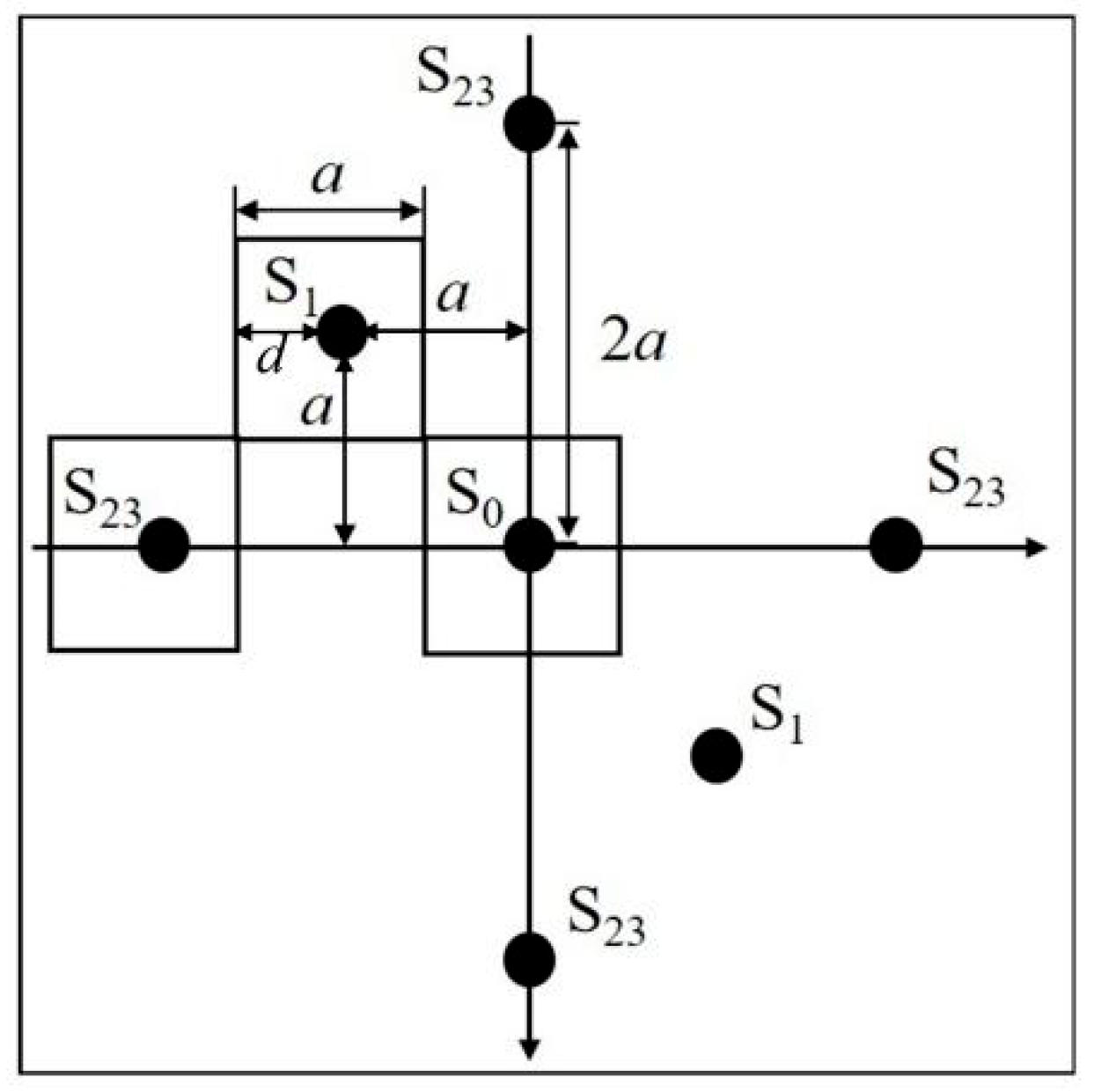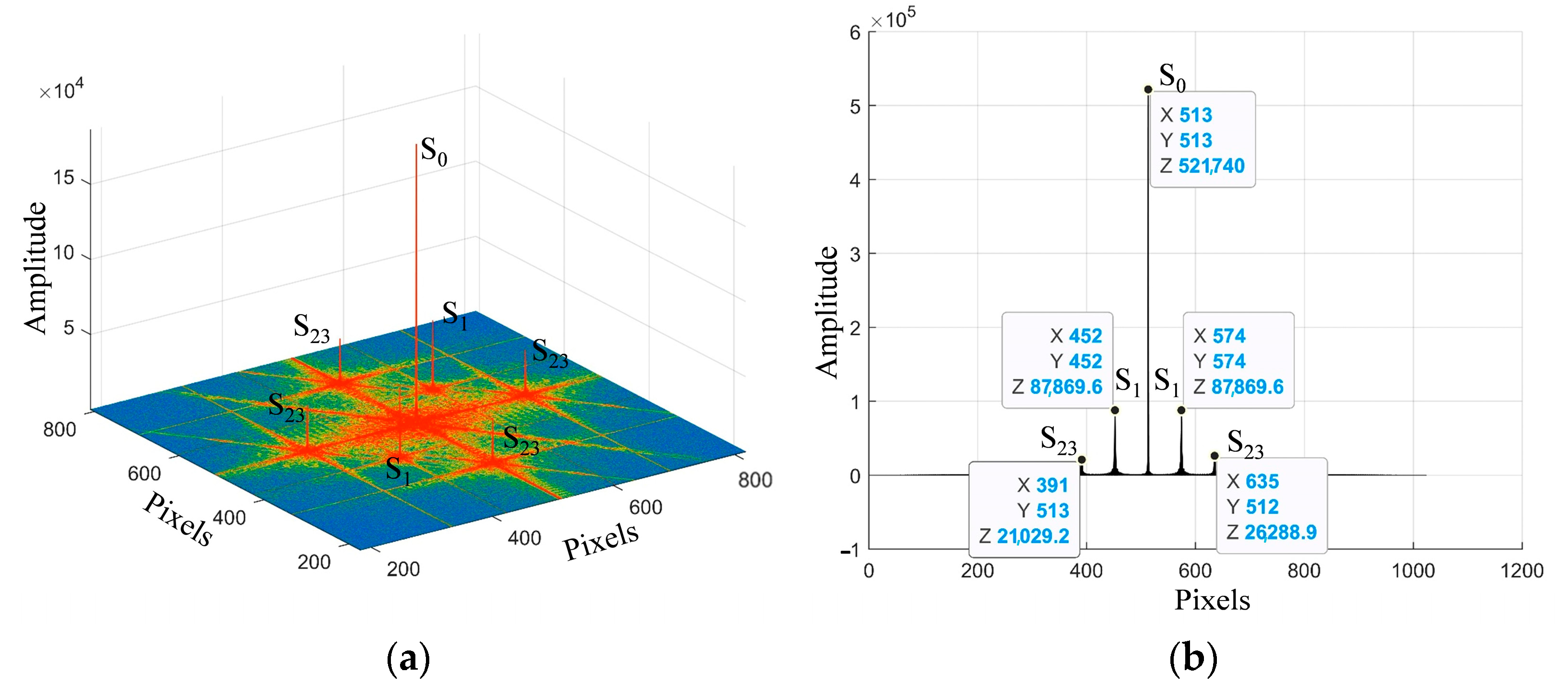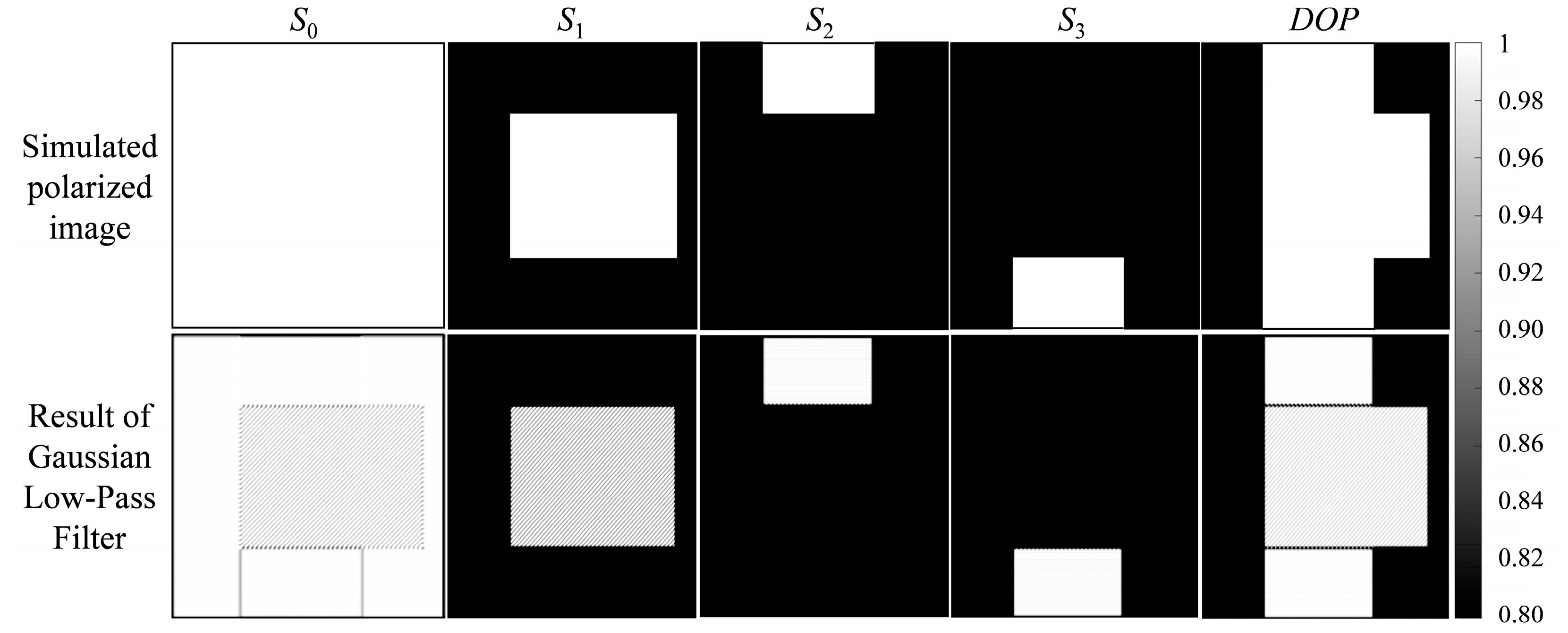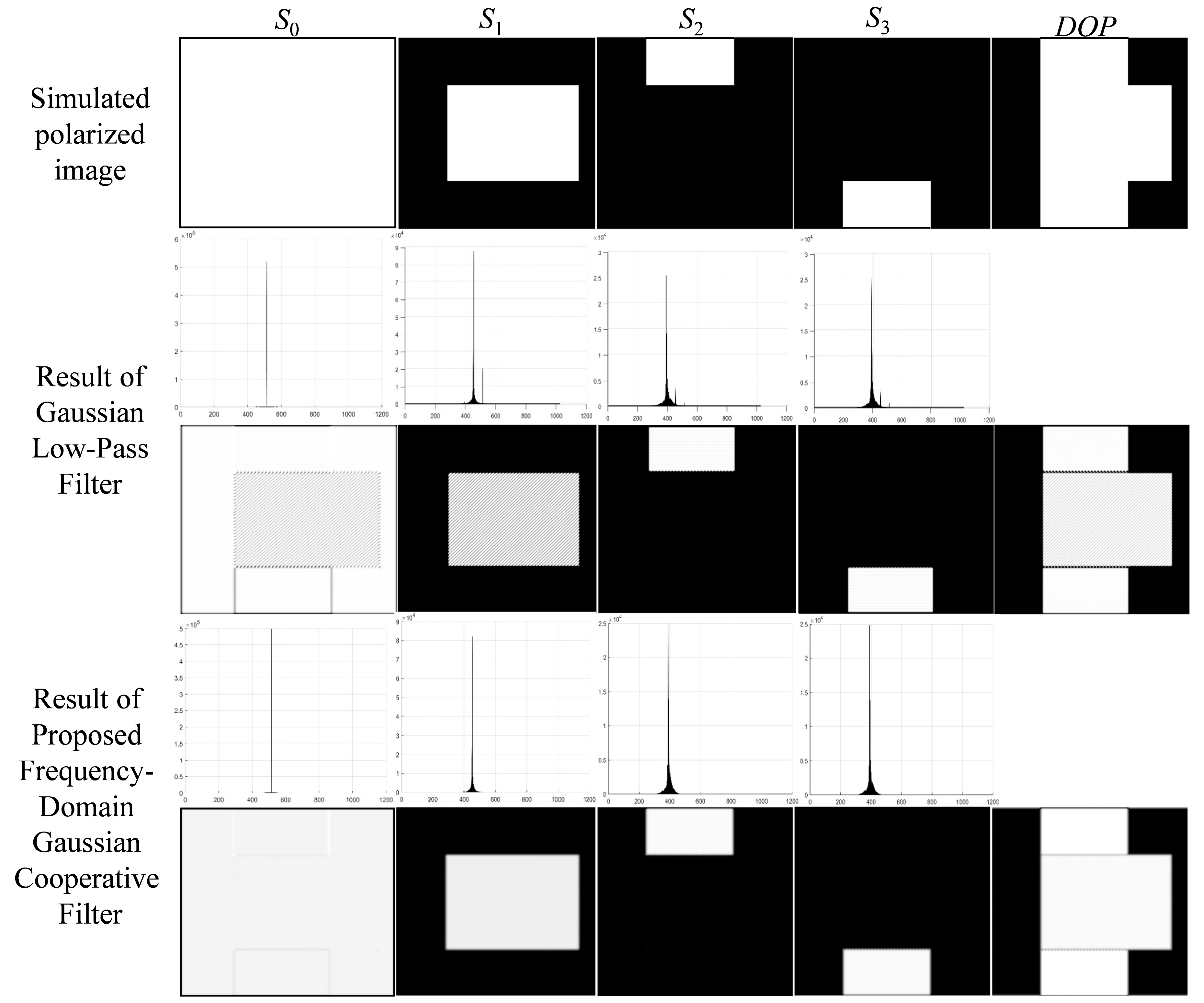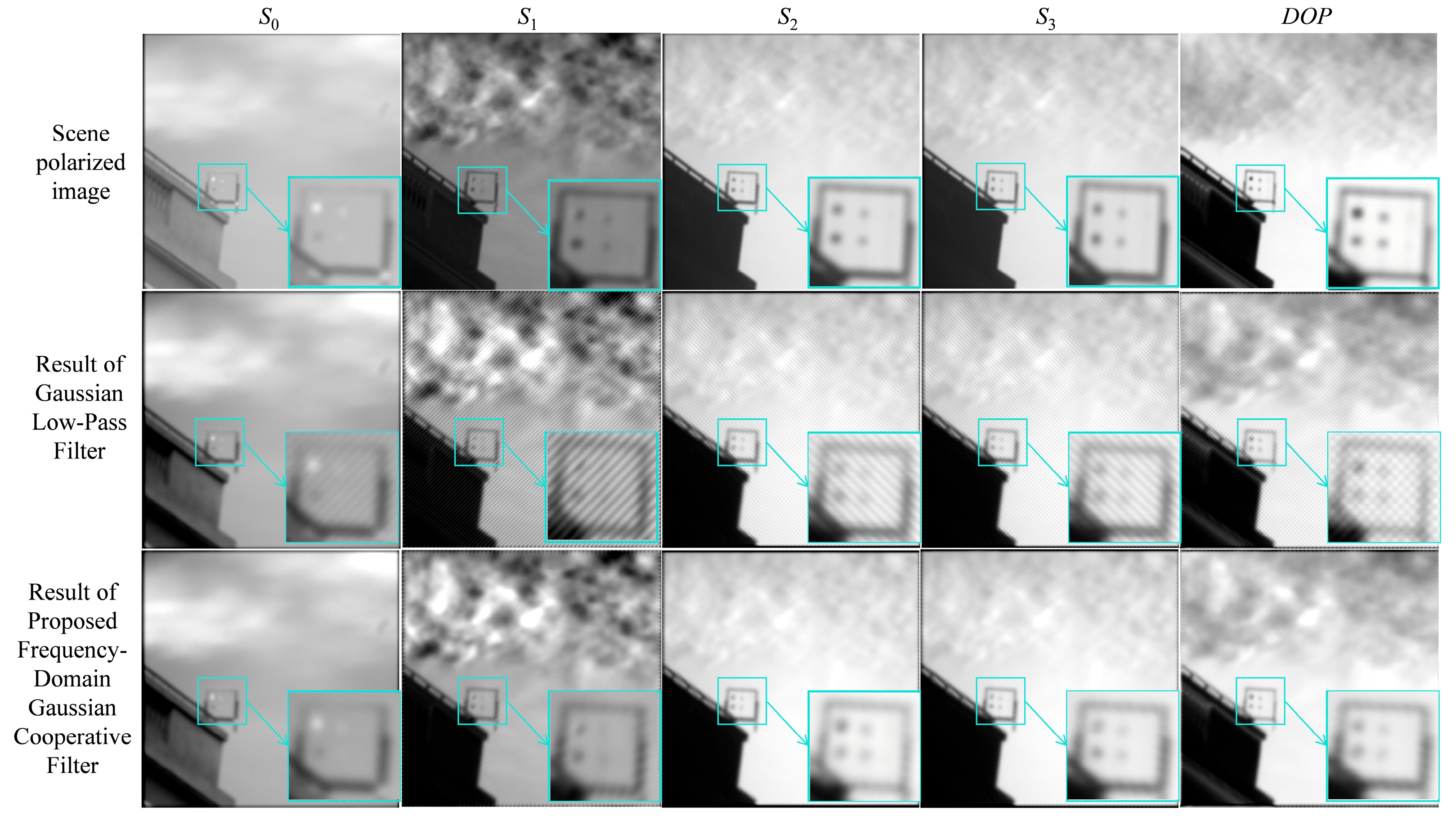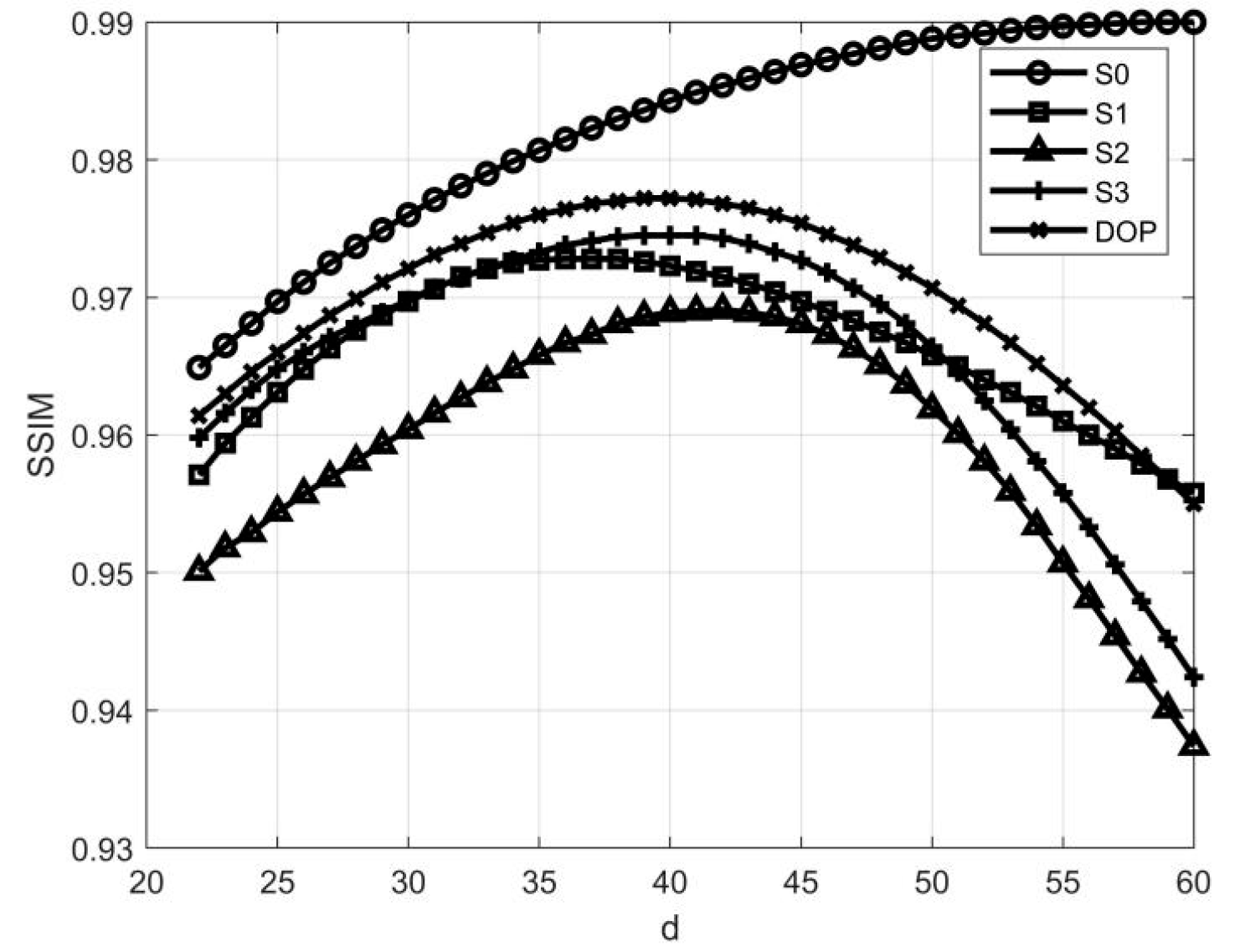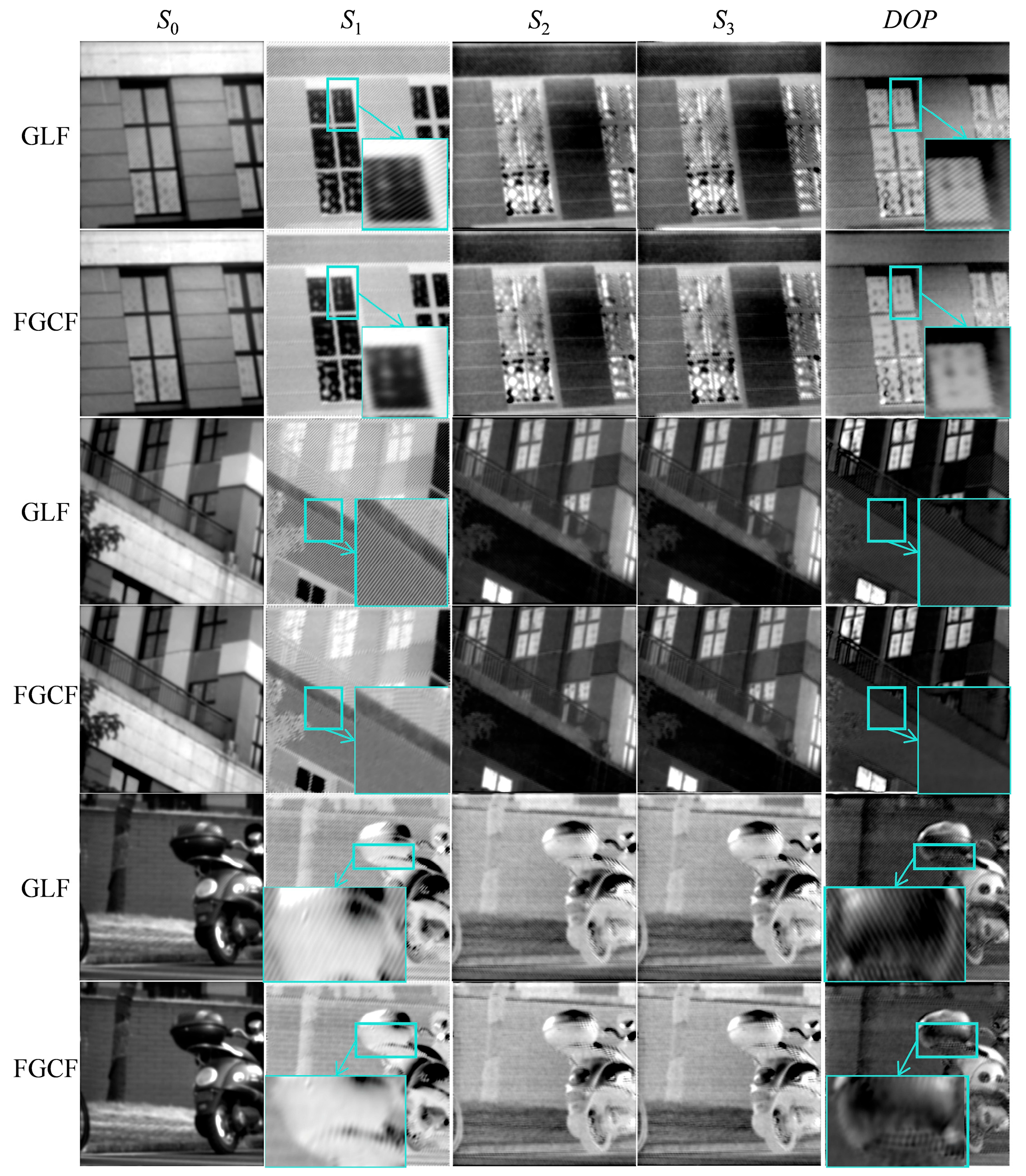1. Introduction
Polarization, as a crucial property of light, holds significant potential in various fields. In environmental monitoring, it aids in atmospheric correction and ocean color measurements [
1]. In medicine, it enhances imaging in turbid tissues [
2]. For military applications, it helps detect camouflage and landmines [
3]. In agriculture, it is used for forest canopy height estimation [
4]. In remote sensing, deep learning is increasingly applied to improve polarization imaging [
5,
6]. To further extend its application scope and depth, efficient and precise acquisition of polarization information is crucial.
Polarization imaging acquisition techniques have evolved through multiple stages, beginning from the simple addition of polarizers in front of cameras, and advancing to time-sequential polarization imaging based on mechanical or liquid-crystal waveplates, amplitude-splitting polarization imaging using beam splitters, aperture-splitting polarization imaging based on wavefront splitting principles, focal-plane-division polarization imaging using micro-polarizer arrays, and spatially modulation full-polarization imaging using birefringent crystals [
7,
8,
9,
10,
11,
12]. However, each of these methods has its inherent limitations. For example, time-sequential polarization imaging suffers from complex control, imaging errors, and is limited in applicability to static targets. Amplitude-splitting polarization imaging divides incident light into multiple paths, resulting in reduced signal strength and a bulky apparatus. Aperture-splitting polarization imaging segments the imaging surface, significantly decreasing spatial resolution. Focal-plane-division polarization imaging, while enabling snapshot acquisition of full-Stokes parameters, suffers from limitations such as reduced efficiency in light transmission due to the need for micro-polarizer arrays, and a decrease in image quality caused by optical misalignments or polarization crosstalk between adjacent polarizers.
In contrast, spatially modulation full-polarization imaging systems utilize the special birefringent properties of crystals to simultaneously encode all polarization information into a single interferogram. This approach exhibits significant advantages, such as capturing comprehensive polarization information in a single frame and simplifying assembly processes. Since its initial proposal by Oka and Saito, the approach has undergone notable improvements, transitioning from birefringent wedge prisms to Savart prisms, effectively reducing manufacturing complexity [
13]. Luo H.T. et al. developed a snapshot imaging prototype based on the Savart prism principle and verified its polarization imaging capabilities experimentally [
14]. Subsequently, Zhang C.M. and Cao Q.Z. et al. optimized the distribution of polarization information in the frequency domain by adjusting the orientation of crystal axes in Savart plates, significantly reducing interference between polarization signals. This approach also enhanced the demodulation process, allowing for the extraction of a wider variety of polarization information, thereby improving the richness and accuracy of the reconstructed images and offering more comprehensive insights into the polarization characteristics [
15,
16]. Furthermore, Zhang N. et al. introduced a Dispersion Compensated Savart Plate (DCSP) comprising two birefringent crystals with distinct dispersion properties, enabling shear displacement proportional to wavelength and effectively mitigating the negative effects of dispersion [
17].
In terms of demodulation schemes, Long, J et al. proposed a method to preserve high-frequency phase information in off-axis quantitative phase imaging by filtering intrinsic mode functions, using empirical mode decomposition (EMD) for zero-frequency component suppression. This method improves phase reconstruction accuracy compared to traditional techniques [
18]. Qiang F. et al. thoroughly investigated the impact of parameter deviations within imaging systems on polarization reconstruction quality, especially examining frequency domain spectral shifts under non-ideal conditions [
19]. Zhang J. et al. introduced a dual-channel spatially modulated snapshot imaging polarimeter, the system captures two antiphase interference patterns, enabling full-resolution and crosstalk-free polarization components in a single exposure to eliminate crosstalk and improve spatial resolution [
20]. Yan H.F. and Ye S. et al. compared several filter performances, determined the advantages of Gaussian low-pass filters, and proposed a method to adjust filter bandwidth based on maximum spectral value, effectively reducing polarization detection errors [
21,
22]. Wang S.C. et al. further optimized the two-dimensional Fourier transform demodulation algorithm, introducing a direction-selective, two-dimensional Hanning window with Bessel correction, effectively improving diagonal-direction interference suppression in the frequency domain [
23].
Despite the substantial progress in imaging and demodulation performance achieved through these studies, interference between polarization information in frequency-domain demodulation, particularly when using single Gaussian low-pass filter methods, remains unresolved and cannot be ignored. To address this issue, this paper proposes a novel Frequency-domain Gaussian Cooperative Filter (FGCF). Unlike traditional filtering approaches, FGCF employs a cooperative mechanism of multiple high-pass and low-pass filters to achieve a new filtering paradigm. Specifically, six Gaussian high-pass filters are designed to identify and suppress interference signals at various positions in the frequency domain, while a Gaussian low-pass filter (GLF) is employed to preserve core polarization information. The cooperative action, achieved by multiplying the low-pass filter response with the complementary high-pass filter responses, effectively optimizes information retention and interference suppression simultaneously during frequency-domain demodulation.
2. Principle of Polarization Imaging and Frequency-Domain Demodulation Process
The spatially modulation polarization imaging system used in this paper relies on the birefringence effect generated by the Savart prism structure to modulate polarization information of the target through lateral shear interference.
Figure 1 illustrates the optical structure of the spatially modulation full-polarization imaging system. The system primarily consists of a collimating lens, a narrowband filter, Savart prism 1 (SP1), a 22.5° half-wave plate, Savart prism 2 (SP2), a 45° analyzer, an imaging lens, and a CCD detector. Each Savart prism comprises two equally thick calcite crystals bonded together, as depicted in
Figure 1a,b. Each crystal’s optical axis forms a 45° angle with the incident plane, and the optical axes of the two crystals are perpendicular to each other. When a light beam is incident perpendicularly, the birefringent effect of the crystal splits the incident light into ordinary (o-ray) and extraordinary (e-ray) beams, resulting in lateral shear at the exit surface.
After passing through the collimating lens, the incident light becomes a parallel beam, subsequently filtered by a narrowband filter with a central wavelength λ and bandwidth Δλ. The filtered parallel beam then enters the SP1 and is split into o-ray and e-ray beams with orthogonal vibration directions, creating lateral shear at the exit surface. These two beams then pass through a half-wave plate oriented at 22.5°, altering their polarization states. When these rotated beams enter the SP2, each beam undergoes another birefringent split, ultimately forming four beams with different polarization states and propagation directions, accompanied by additional lateral shear. These four beams subsequently pass through a linear polarizer oriented at 45°, projecting them onto the same polarization direction to satisfy coherent superposition conditions. Finally, the imaging lens forms an image of the interference field on the CCD detector, generating an interferogram containing the target polarization information. This polarization information is represented by the Stokes vector [
S0,
S1,
S2,
S3], and the interferogram intensity is given by Equation (1):
Here, t represents the thickness of the individual plates comprising the Savart prism, no and ne are the refractive indices of o-ray and e-ray in the Savart prism, respectively, λ represents the central wavelength of the incident beam, f is the focal length of the imaging lens, Δ represents the lateral shear produced by the Savart prism plate, and Ω is the carrier frequency.
During spatial modulation imaging, each Stokes polarization component is modulated onto specific carrier frequencies. These polarization signals become spatially separated in the frequency domain, as illustrated in
Figure 2. Parameter
a refers to the characteristic dimension of the low-pass filter, which is determined by the positions where each polarization component is modulated in the frequency domain, and
d corresponds to the radius of the filters. Because each polarization signal occupies a distinct frequency position, frequency-domain filtering techniques can effectively separate and extract each polarization component.
The frequency-domain demodulation method is based on this principle. Initially, the acquired interferogram undergoes a two-dimensional Fourier transform, converting spatial-domain interference signals into the frequency domain. The transformed Equation is:
where
F0,
F1,
F23, and
F23* represent the two-dimensional Fourier transforms of the Stokes parameters
S0,
S1,
S23, and
S23* respectively,
S23* is the complex conjugate of
S23 with
S23 =
S2 +
iS3 and
S23* =
S2 −
iS3. The parameter
α = ΩDN indicates the spectral shift (as shown in
Figure 2), where D is the CCD pixel size and N is the number of rows (or columns) of the CCD, assuming equal rows and columns in this paper.
As different polarization information occupies distinct positions in the frequency domain, appropriate frequency-domain filtering can separately extract each polarization component. Subsequent inverse Fourier transforms yield the corresponding polarization information. The demodulated polarization information is calculated as follows:
Here, Re[S23(x,y)] and Im[S23(x,y)] denote the real and imaginary parts of S23(x,y), respectively, while DOP represents the degree of polarization.
However, when employing a traditional single Gaussian low-pass filter for frequency-domain demodulation, considerable interference arises due to overlapping signals centered around various modulation frequency bands, significantly impacting demodulation accuracy. To address this issue, a detailed analysis and corresponding optimization strategy will be presented in the subsequent section.
3. Analysis of Frequency-Domain Demodulation Schemes
This section first analyzes the traditional frequency-domain demodulation approach using Gaussian low-pass filters (GLF) to identify existing issues and provide a theoretical basis for the FGCF proposed in this study. A simulation experiment was designed with the following optical parameters: the Savart plate is made of calcite with refractive indices
no = 1.662 and
ne = 1.488, single plate thickness
t = 3.55 mm, incident light center wavelength
λ = 569 nm, imaging lens focal length
f = 110 mm, CCD pixel size 10 μm, and CCD pixel count N = 1024. The constructed simulation images of each Stokes component are illustrated in
Figure 3.
Figure 3 presents the simulated polarization images, including four Stokes components and one polarization degree image, with white pixel regions assigned a value of 1 and black pixel regions assigned a value of 0. The simulated polarization images were substituted into the polarization imaging formula to generate interferograms, followed by Fourier transformation to obtain the corresponding frequency-domain images. To clearly illustrate the frequency-domain distribution characteristics of polarization information,
Figure 4 presents distributions from different perspectives.
Figure 4a provides a three-dimensional view of polarization information distribution in frequency space, while
Figure 4b shows a two-dimensional front view, clearly displaying positions and peak intensities of polarization signals. It is evident that the Stokes polarization components occupy distinct positions in the frequency domain and differ in information content.
S0 contains abundant and concentrated information beneficial for demodulation; however, it introduces significant interference to neighboring polarization components, particularly the closely situated
S1.
Next, the demodulation effect using a Gaussian low-pass filter was analyzed. According to polarization positions in the frequency domain, filter parameters were optimized, with minimal interference at a filter radius of
d =
a/2 (as shown in
Figure 2). The filtered frequency-domain distributions of Stokes polarization information are depicted in
Figure 5.
Figure 5 illustrates the filtering effects on
S0,
S1, and
S23 from left to right. It is observed that, when extracting
S0, both
S1 and
S23 signals are significantly suppressed, resulting in excellent demodulation quality for
S0. Conversely, when extracting
S1 and
S23, substantial residual interference from other polarization signals remains, affecting subsequent demodulation accuracy. The demodulated polarization images obtained using Gaussian low-pass filtering are shown in
Figure 6.
In
Figure 6, the first row shows the original simulated images, and the second row presents the results obtained using Gaussian low-pass filtering. The comparison clearly demonstrates noticeable interference, particularly in
S1, consistent with frequency-domain analysis in
Figure 5, indicating significant interference from the adjacent strong
S0 signal.
Thus, a single Gaussian low-pass filter proves insufficient in suppressing interference from neighboring polarization signals. To address this issue, this paper proposes the FGCF, consisting of six Gaussian high-pass filters targeting interference signals and one Gaussian low-pass filter preserving key information. The cooperative mechanism, achieved through multiplication of low-pass and complementary high-pass filter responses, significantly enhances filtering performance.
The construction of the FGCF requires first determining the frequency-domain positions of polarization signals. Initially, positions are estimated based on optical parameters, and precise positions are subsequently identified through local peak detection, defined as P = {(xs01,ys01), (xs11,ys11), (xs12,ys12), (xs231,ys231), (xs232,ys232), (xs233,ys233), (xs234,ys234)}. The center of the Gaussian low-pass filter is set at (j,k) = P{v}, and the six Gaussian high-pass filters are centered at (r,w) = P − P{v}.
The transfer functions for the Gaussian low-pass and high-pass filters are defined respectively as:
The total transfer function of the FGCF is the product of the low-pass and high-pass filter transfer functions:
The construction process of FGCF based on Equations (5)–(7) is illustrated in
Figure 7.
Demodulation experiments using FGCF were performed on simulated interferograms and compared with GLF results, as shown in
Figure 8.
In
Figure 8, the first row presents original simulation images, the second and fourth rows depict frequency-domain distributions after GLF and FGCF filtering, respectively, and the third and fifth rows show corresponding demodulated Stokes images. Comparison clearly demonstrates that FGCF significantly reduces interference from other polarization signals, thereby improving demodulation accuracy.
For quantitative evaluation of the two methods, Structural Similarity Index (SSIM) was employed:
where
L(x,y),
C(x,y), and
S(x,y) represent luminance, contrast, and structural similarity, respectively;
ux,
uy are pixel means;
σx,
σy are pixel variances;
σxy is pixel covariance; and
C1,
C2,
C3 are constants,
C3 =
C2/2; the symbol * in this equation represents multiplication. SSIM values range from [0, 1], with higher values indicating greater similarity.
Table 1 lists SSIM values comparing the two demodulation methods.
Table 1 shows that FGCF substantially outperforms GLF in interference suppression, particularly for extracting
S1. The combined qualitative and quantitative analyses confirm that the FGCF approach effectively addresses interference issues between neighboring polarization signals, significantly improving demodulation accuracy.
4. Experimental Analysis
In this study, a partial amplitude polarization camera was first used to acquire polarization images of real scenes, obtaining images in three linear polarization directions. From these images, the Stokes parameters
S0,
S1, and
S2 were calculated using relevant formulas. As the camera did not provide information about the circular polarization component (
S3), we approximated
S3 was set as
S2/2. Based on these derived Stokes images, simulation experiments of spatially modulation full-polarization imaging were conducted. The experimental parameters were set as follows: Savart plates made of calcite with refractive indices
no = 1.662 and
ne = 1.488, single plate thickness
t = 3.55 mm, incident light center wavelength
λ = 569 nm, imaging lens focal length
f = 110 mm, pixel size 10 μm, CCD pixel count N = 1024, parameter
a = 64, and filter radius
d = 32. The Gaussian low-pass filter (GLF) and the frequency-domain Gaussian cooperative filter (FGCF) were employed separately for demodulation, with the experimental results shown in
Figure 9.
As observed in
Figure 9, the first row represents standard polarization images from real scenes, while the second row shows demodulated images obtained by the GLF scheme. Due to interference among polarization signals, significant interference artifacts appear in the demodulated images.
S0, having the strongest signal intensity, is least affected, whereas
S1, adjacent to the strongest signal
S0, exhibits the most pronounced interference. The third row illustrates the results demodulated using the FGCF scheme, which significantly reduces interference from other polarization components compared to GLF, particularly enhancing the demodulation quality of
S1.
To further evaluate these two demodulation methods quantitatively, the SSIM between the demodulated images and standard polarization images was calculated, as shown in
Table 2.
Results from
Table 2 indicate that the GLF scheme performs poorly overall, particularly for S
1, with an SSIM value of only 0.4408 due to severe interference from
S0. In contrast, the FGCF scheme considerably improves demodulation quality, significantly elevating SSIM values across all Stokes parameters and
DOP. Notably, the SSIM value for
S1 increases by 0.5306, highlighting the FGCF’s effectiveness in suppressing interference.
In the aforementioned experiment, the filter radius was initially set to
d =
a/2 primarily to suppress interference from other polarization components. Given FGCF’s effective interference suppression, it was hypothesized that increasing the filter radius
d could further enhance the extraction of useful polarization information. To test this hypothesis, experiments with varying filter radii were performed, and corresponding SSIM values were calculated, as depicted in
Figure 10.
As shown in
Figure 10, the SSIM of S
0 steadily increases with rising d, indicating improved information extraction. Conversely, the SSIM values of
S1,
S2,
S3, and
DOP initially increase and subsequently decline, with the
DOP reaching its maximum SSIM at
d = 39. This indicates that within the range 22 ≤
d ≤ 39, the increase in information extraction outweighs interference, whereas for
d > 39, interference, primarily high-frequency polarization information, dominates since low-frequency interference has been effectively removed. Thus, appropriately increasing the filter radius d within the FGCF scheme can further enhance polarization information extraction.
To validate FGCF performance further at a filter radius of
d = 39, additional experiments based on imaging with a partial-amplitude polarization camera were conducted, with results shown in
Figure 11.
Figure 11 illustrates three polarization image demodulation experiments under different scenes, with rows 1 and 2, rows 3 and 4, and rows 5 and 6 corresponding respectively to GLF and FGCF results for each scene. The comparisons clearly demonstrate that FGCF effectively reduces interference even at
d = 39.
Quantitative evaluation was further conducted by calculating SSIM values for these three sets of experiments, presented in
Table 3.
The data in
Table 3 further confirms significant improvements with FGCF, as all SSIM values remain above 0.9, indicating high similarity between the demodulated and standard polarization images. The most remarkable improvement is observed for S
1, demonstrating FGCF’s exceptional capability to suppress interference from other polarization signals.
5. Conclusions
To address interference issues among polarization components in spatially modulation full-polarization imaging system demodulation, this paper proposes a frequency-domain Gaussian cooperative filter. This method incorporates six Gaussian high-pass filters specifically targeting interference signals and a Gaussian low-pass filter designed to preserve critical information. The cooperative operation between the high-pass and low-pass filter responses optimizes overall polarization information demodulation.
Simulation experiments demonstrate significant enhancement in demodulation performance using frequency-domain Gaussian cooperative filter compared to the traditional Gaussian low-pass filter method, especially for polarization information S1, where the SSIM value increased by over 0.5, substantially mitigating interference from other polarization signals. Additionally, the study explored and experimentally verified that appropriately increasing the filter radius could further improve the extraction of effective polarization information.
However, this research primarily focused on precise filtering of low-frequency interference. Future studies will explore more effective suppression techniques for high-frequency interference to comprehensively enhance the demodulation performance of spatially modulation full-polarization imaging systems.

